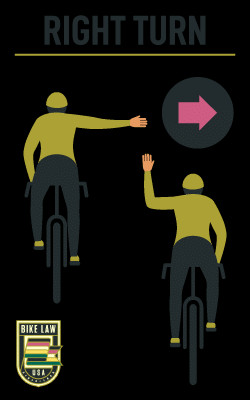Before hitting the road on your bicycle, understanding and using Bike Signals is as crucial as knowing traffic laws. Just like drivers use signals in cars, cyclists rely on hand signals to communicate their intentions to motorists, pedestrians, and fellow riders. These signals are not just a formality; they are a vital safety measure that can significantly reduce the risk of accidents and misunderstandings on the road. Analyzing numerous bicycle accident case results underscores the critical role of clear communication in preventing road mishaps. Learning and consistently using these fundamental bike hand signals is a proactive step towards ensuring your safety and the safety of others.
If you’re new to cycling or haven’t made hand signals a regular part of your rides, now is the perfect time to start. Below, we’ll explore the essential bike signals every cyclist should know to promote predictable riding and enhance safety on every journey.
Why Learning Bike Hand Signals is Non-Negotiable for Safety
In a single year, over 1,000 cyclists tragically lost their lives, and nearly half a million sustained injuries in bicycle accidents. While factors like road conditions and infrastructure play a role, a significant portion of these incidents stem from miscommunication between cyclists and drivers.
Bike hand signals act as a crucial communication bridge, minimizing the chance of collisions with cars. While no signal can eliminate all risks associated with negligent drivers, clearly signaling your intended actions significantly increases your visibility and predictability on the road, making it less likely for motorists to misjudge your movements.
The importance of bike signals extends beyond interactions with cars. For cyclists riding in groups or in areas with shared bike paths, hand signals are equally vital for communicating with fellow cyclists. Whether you’re in a tight-knit peloton or simply sharing the road, signaling intentions to stop, slow down, or turn provides crucial reaction time for others, preventing potential chain reactions and collisions among cyclists.
The Top Bike Hand Signals Every Cyclist Must Know
Here are the three fundamental bike hand signals that form the bedrock of safe cycling communication. Before signaling, always perform a quick head check to assess your surroundings and make eye contact with drivers and cyclists around you. This ensures your signals are seen and understood, enhancing overall road awareness.
Ideally, initiate your signal about 100 feet before you plan to turn or stop. This lead time allows ample opportunity for other road users to react and adjust, and it also allows you to safely return both hands to your handlebars as you execute your maneuver. Hold each signal for approximately three seconds to ensure it’s clearly perceived.
Signaling a Left Turn
To indicate a left turn, simply extend your left arm fully out to your side, horizontally. Initiate this signal roughly 100 feet before your turn to provide sufficient warning and allow you to regain full control of your bike with both hands as you navigate the turn.
Signaling a Right Turn
 cyclist signaling a right turn by extending right arm
cyclist signaling a right turn by extending right arm
There are a couple of accepted methods for signaling a right turn. The most straightforward and commonly recognized method is to extend your right arm straight out to your side, mirroring the left turn signal but on the opposite side.
However, some regions or guides may recommend an alternative right turn signal. This involves extending your left arm out to the side and then bending your forearm upwards at a 90-degree angle, with your hand pointing upwards. Regardless of the specific right turn signal you choose to use, consistency is key. Ensure you signal about 100 feet prior to turning and maintain the signal for around 3 seconds for maximum clarity.
Signaling “Stop” or Slowing Down
The stop signal is arguably the most frequently used hand signal for cyclists, especially because bicycles typically lack brake lights found on cars. To signal that you are stopping or decelerating, extend your left arm out to the side and then bend your forearm downwards at a 90-degree angle, with your hand open and pointing towards the ground. This signal is universally understood and essential for preventing rear-end collisions.
Injured in a Cycling Accident? The Bike Law Network Can Assist.
Experiencing a bike crash can be a profoundly distressing event for any cyclist. The aftermath of being hit by a car can involve not only physical pain and injuries but also emotional trauma and complex legal questions. We are here to offer support.
If you require expert assistance following a bicycle accident, the Bike Law Network connects you with specialized professionals, including experienced attorneys like a Florida bicycle accident lawyer, who possess a deep understanding of the unique challenges cyclists face. The Bike Law Network is a collective of independent lawyers and law firms united by a shared dedication to the cycling community. Contact us today at 1-866-370-8796 to connect with a Bike Law Lawyer and explore your options.
 Peter Wilborn, founder of Bike Law, bicycle crash lawyer
Peter Wilborn, founder of Bike Law, bicycle crash lawyer
Peter Wilborn
Peter Wilborn, the founder of Bike Law and a dedicated bicycle crash lawyer, is an avid cyclist with extensive experience in racing, touring, commuting, and recreational riding. Driven by a personal family bike tragedy in 1998, Peter recognized the critical need for legal professionals who truly understand the cycling world. This realization led him to dedicate his legal practice entirely to Bike Law.
LinkedIn Profile of Peter Wilborn Instagram Profile of Bike Law Peter Facebook Page of Bike Law
